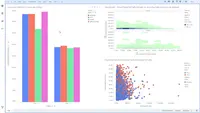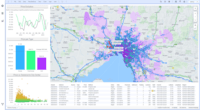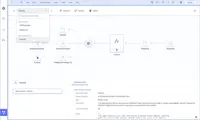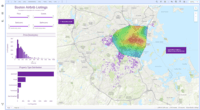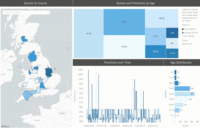Overview
What is Spotfire?
Spotfire® is a data visualization platform that utilizes predictive analytics. In addition to data viz, it includes data wrangling capabilities, predictive analytics, location analytics, and real-time streaming analytics. Spotfire® is a business unit of Cloud Software Group, formerly known…
Flexible, fast and effective data analytics tool.
Leveraging Data for Enhanced Sales Strategy using Spotfire
Spotfire capability assessment from uday to day usage
Fast and Accurate Market decision making
Insightful Manufacturing Process Interogation
Feels like a BI-Tool on Steroids
Spotfire is a powerful Visualization Tool.
Spotifire is spot-on!
Very good with visualizations
Spotfire - Make you data analysis easier
Spotfire for the Energy Industry
Very good interactive inmersive analytics for predictive maintenance
Powerful BI Platform, but Requires IT Support
Reliable and always available SaaS BI tool to handle easily massive amount of data
How Spotfire Differs From Its Competitors
Integrations with other TIBCO products
Integrations with other TIBCO products
Integrations with other TIBCO products
Integrations with other TIBCO products
Integrations with other TIBCO products
Integrations with other TIBCO products
Integrations with other TIBCO products
Integrations with other TIBCO products
Integrations with other TIBCO products
Integrations with other TIBCO products
Integrations with other TIBCO products
Integrations with other TIBCO products
- Amazon Redshift
- Apache Hive
- Apache Kafka
- PostgreSQL
- MS SQL
- MySQL
Integrations with other TIBCO products
Breadth of Deployment
Integrations with other TIBCO products
Integrations with other TIBCO products
Integrations with other TIBCO products
Integrations with other TIBCO products
Integrations with other TIBCO products
Integrations with other TIBCO products
Integrations with other TIBCO products
Integrations with other TIBCO products
Integrations with other TIBCO products
Integrations with other TIBCO products
Integrations with other TIBCO products
Awards
Products that are considered exceptional by their customers based on a variety of criteria win TrustRadius awards. Learn more about the types of TrustRadius awards to make the best purchase decision. More about TrustRadius Awards
Popular Features
- Customizable dashboards (294)9.191%
- Pre-built visualization formats (heatmaps, scatter plots etc.) (306)8.686%
- Drill-down analysis (289)8.383%
- Formatting capabilities (302)7.878%
Reviewer Pros & Cons
Video Reviews
1 video
Pricing
Spotfire for Amazon Web Services
$0.99
Spotfire Cloud - Consumer
$250/yr
Spotfire Cloud - Business Author
$650/yr
Entry-level set up fee?
- No setup fee
Offerings
- Free Trial
- Free/Freemium Version
- Premium Consulting/Integration Services
Features
BI Standard Reporting
Standard reporting means pre-built or canned reports available to users without having to create them.
- 8Pixel Perfect reports(30) Ratings
Pixel Perfect reports are highly-formatted reports with graphics and ability to preview the report before printing.
- 9.1Customizable dashboards(294) Ratings
Customizable dashboards are dashboards providing the builder some degree of control over the look and feel and display options.
- 7.9Report Formatting Templates(258) Ratings
Ad-hoc Reporting
Ad-Hoc Reports are reports built by the user to meet highly specific requirements.
- 8.3Drill-down analysis(289) Ratings
Drill down analysis is the ability to get to a further level of detail by going deeper into the hierarchy.
- 7.8Formatting capabilities(302) Ratings
Ability to format output e.g. conditional formatting, lines, headers, footers.
- 8.3Integration with R or other statistical packages(224) Ratings
Integration with the open-source R predictive modeling environment.
- 8.5Report sharing and collaboration(274) Ratings
Report sharing and collaboration is the ability to easily share reports with others.
Report Output and Scheduling
Ability to schedule and manager report output.
- 8.2Publish to Web(228) Ratings
- 8.6Publish to PDF(267) Ratings
- 8Report Versioning(18) Ratings
Report versioning is the assignment of version numbers to each version of a report to help in tracking.
- 8.4Report Delivery Scheduling(178) Ratings
Report Delivery Schedule is the ability to have reports delivered to a destination at a specific data and time.
Data Discovery and Visualization
Data Discovery and Visualization is the analysis of multiple data sources in a search for patterns and outliers and the ability to represent the data visually.
- 8.6Pre-built visualization formats (heatmaps, scatter plots etc.)(306) Ratings
Pre-built visualization formats are canned visualization types that can be selected to visualize different kinds of data.
- 8.4Location Analytics / Geographic Visualization(271) Ratings
Location analytics is the visualization of geographical or spatial data.
- 8.1Predictive Analytics(234) Ratings
Predictive Analytics is the ability to build forecasting models based on existing data sets.
- 7.6Pattern Recognition and Data Mining(8) Ratings
Pattern recognition and data mining mean the ability to recognize hidden patterns in large quantities of data.
Access Control and Security
Access control means being able to determine who has access to which data.
- 8.7Multi-User Support (named login)(241) Ratings
Named model access means that users have access based on name and password.
- 8.5Role-Based Security Model(206) Ratings
Role-based access means that access to data is determined by job or position in the corporation.
- 7.8Multiple Access Permission Levels (Create, Read, Delete)(228) Ratings
Multiple access permission levels means that different levels of users have different rights.
- 7.4Report-Level Access Control(8) Ratings
Report-level access control means that the type of report determines who has access to it.
Mobile Capabilities
Support for mobile devices like smartphones and tablets.
- 7.9Responsive Design for Web Access(177) Ratings
Web design aimed at producing easy-to-read sites across a range of different devices.
- 7.6Mobile Application(126) Ratings
A dedicated app for iOS and/or Android.
- 7.5Dashboard / Report / Visualization Interactivity on Mobile(148) Ratings
In-app dashboard reports and data visualization.
Application Program Interfaces (APIs) / Embedding
APIs are a set of routines, protocols, and tools for used for embedding one application in another
- 8.3REST API(71) Ratings
REST is an architecture style for designing networked applications
- 8.3Javascript API(70) Ratings
A Javascript API is a type of API
- 8.4iFrames(54) Ratings
An iFrame is an HTML document embedded inside another HTML document on a website
- 8.2Java API(57) Ratings
A Java application programming interface (API) is a list of all classes that are part of the Java development kit (JDK)
- 8.2Themeable User Interface (UI)(69) Ratings
A themeable user interface means that a specific visual them can be applied to it
- 8.5Customizable Platform (Open Source)(60) Ratings
A customizable, open source API Gateway is a fast and scalable type of API
Product Details
- About
- Integrations
- Competitors
- Tech Details
- Downloadables
- FAQs
What is Spotfire?
The vendor states Spotfire's differentiating hybrid in-memory/in-database analytics architecture supports the most demanding enterprise needs, scaling to thousands of users and limitless rows of data.
Spotfire is deployed in companies in financial services, energy, manufacturing, consumer packaged goods, government, travel & logistics, helathcare, and life sciences.
Spotfire® is a business unit of Cloud Software Group, formerly known as TIBCO Spotfire.
Spotfire Features
BI Platform Features
- Supported: Administration via Windows App
- Supported: Administration via MacOS App
- Supported: Administration via Web Interface
- Supported: Live Connection to External Data
- Supported: Snapshot of External Data
- Supported: In-memory data model
- Supported: OLAP (Pre-processed cube representation)
- Supported: Multi-Data Source Reporting (Blending)
- Supported: Data warehouse / dictionary layer
- Supported: ETL Capability
- Supported: ETL Scheduler
Supported Data Sources Features
- Supported: MS Excel Workbooks
- Supported: Text Files (CSV, etc)
- Supported: Oracle
- Supported: MS SQL Server
- Supported: IBM DB2
- Supported: Postgres
- Supported: MySQL
- Supported: ODBC
- Supported: Cloudera Hadoop
- Supported: Hortonworks Hadoop
- Supported: EMC Greenplum
- Supported: IBM Netezza
- Supported: HP Vertica
- Supported: SAP Hana
- Supported: Teradata
- Supported: Salesforce
- Supported: SAP
- Supported: Google Analytics
BI Standard Reporting Features
- Supported: Customizable dashboards
- Supported: Report Formatting Templates
Ad-hoc Reporting Features
- Supported: Drill-down analysis
- Supported: Formatting capabilities
- Supported: Predictive modeling
- Supported: Integration with R or other statistical packages
- Supported: Report sharing and collaboration
Report Output and Scheduling Features
- Supported: Publish to Web
- Supported: Publish to PDF
- Supported: Output Raw Supporting Data
- Supported: Report Delivery Scheduling
Data Discovery and Visualization Features
- Supported: Pre-built visualization formats (heatmaps, scatter plots etc.)
- Supported: Location Analytics / Geographic Visualization
- Supported: Predictive Analytics
- Supported: Support for Machine Learning models
- Supported: Pattern Recognition and Data Mining
- Supported: Integration with R or other statistical packages
Access Control and Security Features
- Supported: Multi-User Support (named login)
- Supported: Role-Based Security Model
- Supported: Multiple Access Permission Levels (Create, Read, Delete)
- Supported: Report-Level Access Control
- Supported: Table-Level Access Control (BI-layer)
- Supported: Field-Level Access Control (BI-layer)
Mobile Capabilities Features
- Supported: Responsive Design for Web Access
- Supported: Mobile Application
- Supported: Dashboard / Report / Visualization Interactivity on Mobile
Application Program Interfaces (APIs) / Embedding Features
- Supported: REST API
- Supported: Javascript API
- Supported: iFrames
- Supported: Java API
- Supported: Themeable User Interface (UI)
- Supported: Customizable Platform (Open Source)
Spotfire Screenshots
Spotfire Videos
Spotfire Integrations
Spotfire Competitors
Spotfire Technical Details
| Deployment Types | On-premise, Software as a Service (SaaS), Cloud, or Web-Based |
|---|---|
| Operating Systems | Windows, Linux, Mac |
| Mobile Application | Apple iOS, Mobile Web |
| Supported Countries | Available in all regions |
| Supported Languages | English, Spanish, French, German, Portugese, Chinese, Italian |
Spotfire Downloadables
Frequently Asked Questions
Comparisons
Compare with
Reviews and Ratings
(810)Attribute Ratings
- 8.3Likelihood to Renew29 ratings
- 9Availability14 ratings
- 7.1Performance14 ratings
- 8Usability27 ratings
- 8.7Support Rating27 ratings
- 8.8Online Training55 ratings
- 7.3In-Person Training52 ratings
- 8Implementation Rating17 ratings
- 7.1Configurability3 ratings
- 7Product Scalability4 ratings
- 7Ease of integration2 ratings
- 5Vendor pre-sale1 rating
- 5Vendor post-sale1 rating
- 8Data Visualization4 ratings
- 9.3Data Sources36 ratings
- 8.2Data Sharing and Collaboration36 ratings
- 4Tibco Spotfire Smart Recommendations9 ratings
- 8Tibco Spotfire Data Wrangling8 ratings
- 6Tibco Spotfire R Engine7 ratings
- 8.1Tibco Spotfire Mapping30 ratings
Reviews
(26-50 of 335)Spotfire is leading the pack when it comes to highly scalable and capable visual analytics and data modeling
- Machine learning
- Advanced modeling
- Data visualization
- Data ingestion & ETL
- Levels of customization for certain elements
- HTML sanitation removal
- Handling replacement data and the downstream impacts on data functions
Your hidden but most valuable business partner
- Speed
- Easy of use
- streamline admin
- more visuals for next generation usage in mobile
- easier big data access within one installment
Spotfire: quick and easy GIS data visualization
- GIS analytics
- Quick multivariate analysis
- Data presentation for management
- Visualization
- Data manipulation
- User customization
- Large Learning curve
Powerful tool, makes me more efficient!
- Absorbs vast amounts of live & static data.
- Customized dashboards.
- Quick results.
- Some visualizations are a little clunky.
- Could use some refinement in the UI.
- Would like to see more customizable plots/charts.
- Not being able to align gridlines with multiple scales
Spotfire
- Spotfire has a great Geo Analytics platform where Geo-coding is automatically performed from version 6.0 and complex geoanalytics problems can be solved in combination with the Tibco Enterprise Runtime for R (TERR) engine, if the company has R language expertise
- Spotfire has some cool inbuilt functions available through which we do not have to do manual calculations like Total,%Cumulative Sum,YOY,MOM QOQ kind of stuff, and lots other functions which make life simpler
- Iron python scripting is an advantage but, of course, tricky initially if you do not have experience, but it can simplify users' lives if used properly
- Scheduled updates and caching. If we are trying to get the dashboards up in a flash , this feature is useful
- One more important thing in the latest version, is the business author piece on the web player where business users can develop their own stuff on Web, this is a good start and hope to see this developed further
- Spotfire is coming up with new Mobile Metrics platform, i.e. it is responsive on mobile devices
- Also there is a new KPI chart which can be very useful for Executive reporting.
- Customizability on the Analyst end: Spotfire is a good tool, but there are a few points where it should improve. I cannot hide an object like a tab or visualization r
- Data Load speed at the analyst level, I somehow feel when i try to load data in the analyst level it loads slow and while using at webplayer because of the schedule updates it runs fast. I know there is the caching concept, but it is unlike QlikView whichgives a great performance with the desktop version as well. I would expect the same to happen here
Spotfire an excellent software for data analysis
- Data segmentation
- Integration with the most diverse systems
- Ease of use
- Data filter can be improved
- Training materials
- Self-service training
Spotfire is Great
- Easy to create new dashboards
- Display data in an easy to digest form
- Ability to change views on the fly
- Initial Load time is slow
- Graphs aren’t always visually appealing
- More options for input data sources
Spotfire for data virtualisation
- Extract , Transform and Load purpose
- Data virtualisation
- Business analytics
- data virtualisation areas
- interactive dashboards
Flash up data visualization and interpretation with Spotfire
- Data analysis and in-depth visualization
- Generation of graphs and other visuals after analysis are quite great and efficient
- Its support for mobile device is quite great which enables anywhere anytime access
- Great support for dashboards which is quite promising and a prominent part in the analysis
- Best part which makes it even more better is it supports the expression language
- The UI is not flexible in terms of usage. So customization option should be provided so a user can set up as per requirements
- Few features seem to be not stable for example the text editor changes the code layout on its own, so we get different things that we have saved.
- Absorbing and consolidating data from a numerous different provider regions is very difficult to handle and as well as very slow to analyze as it takes a lot of time for visualization
Spotfire is a capable albeit expensive system and other options may be better suited based on your needs
- Ad-hoc data analysis.
- Visualizations.
- Data management / sharing.
- Simplicity of installation.
- Frequency of updates.
- Complication of use.
Spotfire - Better options available
- Enterprise-wide license
- A lot of options to connect to many databases
- Help tools
- The UI can be simpler. Tableau is a lot simpler and neater.
- Options for animations. Sheets like Tableau have it.
- Options for geospatial mapping.
Spotfire Usage and Functionality Review
- Easy to build reports and visualizations.
- Simplifies the process of data federation by allowing definition of data models and information links.
- Spotfire provides [an] easy way for end users to dig deeper and manage data.
- Provide data lineage maps that would help developers.
- More drag and drop functions that facilitate development efforts.
- Need more administrative tasks such as ability to see user activity in structured manners.
- It has the best coding integration (python, R) of any BI product
- The ability to work with very large datasets (10 mil+) is better than competitors
- Export options are more complete and have better functionality
- The data canvas is the best tool to join and transform data vs. competitors
- User interface is less intuitive and changes are more visual than functional.
- Dedicated settings to build solutions for mobile would be appreciated.
- More statistical and analytics functions would be good. The list has been static for a while.
- Drill-down visual creation
- Brushing interaction
- Ease of use of the cloud version
- Cloud documentation
- Pricing for academia (ie. free) - students and faculty using it in a course
- Mac desktop version
- Some complex tutorials/demos
Spotfire is an essential data analysis tool.
- Data connection
- Data visualization
- Web access
- Change management aka GIT
- Labels
- Custom annotations
Great "all in one" platform
- Web player data visualization. They are pretty fast with low server requirements.
- Visualization needs to be from this age. They look sometimes like Office 95. Maybe embedded the Jviz D3 visualization, or integration with Google visualizations.
- Functional dashboards which can be understood quickly by those who use them
- Great visualizations for disparate data sets
- Ease of integration of multiple data sets into one consolidated data table
- Linking of standalone data tables with data pulled from an API link through information links
- Easier mapping integration with data, especially with data of different geospatial projections
- More functionality in spatial sampling
It also should allow users to manually adjust the vertical axis scale as there may be reasoning in modifying it to a smaller or larger range but maintaining the same data step.
It would be ideal to enhance the ability to sort data. For example, there are instances where you want to sort data in a stacked bar chart by something other than count or alphabetically.
Spotfire Review By Beginner User
- Tie to live data sources
- customization with formulas
- sharing work books
- more user friendly interface
- better customization of the asthetics of the charts etc
Spotfire makes my job easier
- Data import is easy.
- Creating visuals is simple and straight forward.
- You can create visuals to show exactly what you need.
- Sometimes it can be difficult to make a formula work exactly as you need in Spotfire. I've experienced many times where a simple formula in Excel doesn't work in Spotfire. There is always something a lot more complicated that needs to be done instead.
Basic review
- Clean and versatile presentation of data.
- Adding and subtracting information in analyses.
- Some data streams should be visibly controlled (colors for gas, oil, and water) should be defaulted.
Spotfire requires some effort, but offers the best combination of advanced analytics with data visualization
- Spotfire performs well for analysts that need more than just real-time data visualizations. These analysts need the ability to create advanced models.
- Spotfire's graphs are a little bit more difficult to create than some other data visualization tools. I think this comes with the advantage of allowing the user a greater ability to customize visualizations.
- The suggested graphs part of creating graphs is world class. It offers more than just one suggestion and makes it easy for the user to create usable graphics.
- The software takes a while to start up. It's almost like using a Windows 7 machine with an old hard drive.
- Sometimes creating the most aesthetically-pleasing graphic takes a long time. This is because of the many adjustments that have to be made to a graph in Spotfire. Some other visualization software makes it easier.
- Although Spotfire has a number of advanced modeling capabilities, it would be nice to have more rather than having to build R scripts for some of the more advanced models.
A Strong Tool to Visualize your Data
- The location and geospatial analysis tools are excellent and are great at giving a geographical context to our data.
- If you are familiar with BI tools, Spotfire is easy to set up and start using.
- There are several options to visualize your data in ways that are compelling and tell a story.
- We are a smaller organization so we always have to justify the cost (it can be a little pricey for smaller organizations).
- Not a bad thing necessarily, but the software is so powerful that I feel like my organization is only scratching the surface with its capabilities. We need some guidance and help with the more advanced features.
- We wish there was more robust documentation available online; it seems to be a bit lacking in certain areas.
Easy to use!
- Analytics.
- Visualization.
- Automation.
- Bad documentation.
- Small user-base.
- Lack of available training.
Advanced and user-friendly business intelligence software
- User-friendliness: People with different backgrounds become expert users of the software very quickly.
- Report management: it is very easy to amend a report modifying formulas, views, and data structures.
- Look and feel: in a well-designed report, it is very easy to find the right insights, thanks to embedded functionalities as marking and filters.
- Some visualizations should be more configurable and customizable.
- Data mapping could be more efficient if represented in a graphical way.
- Company customizations, such as logo and templates, are not immediately accessible to high-level users.
Great product!
- Better Visualizations.
- Data extraction options are easier to use.
- Fast and slick performance.
- Sometimes the customization features in the visualizations can be difficult to work with.
- Data loading performance is not always the best.
- Lack of material design and newer UI features.


